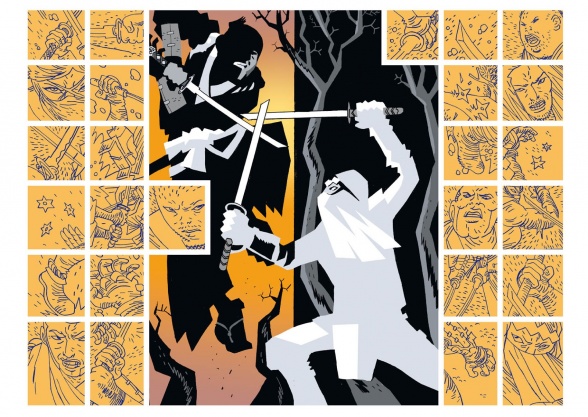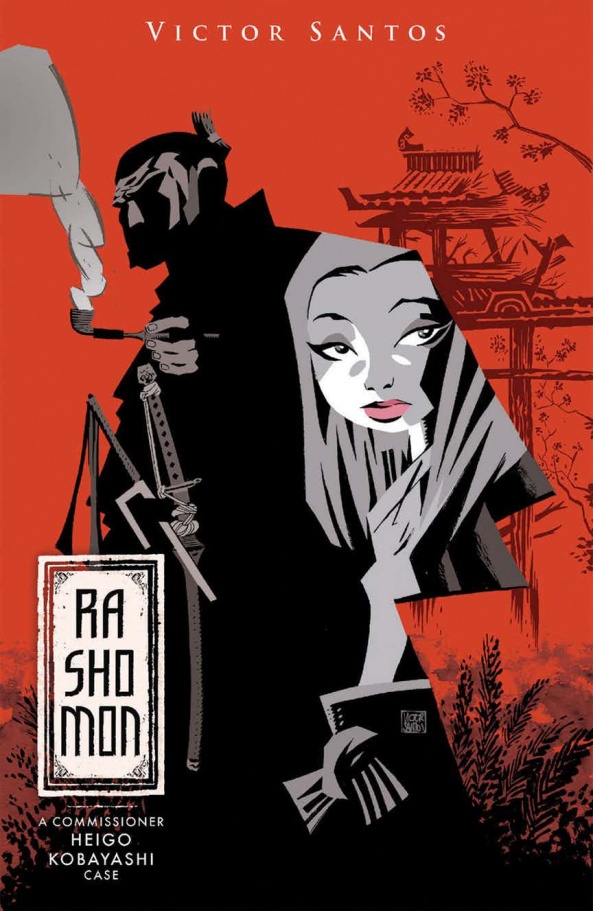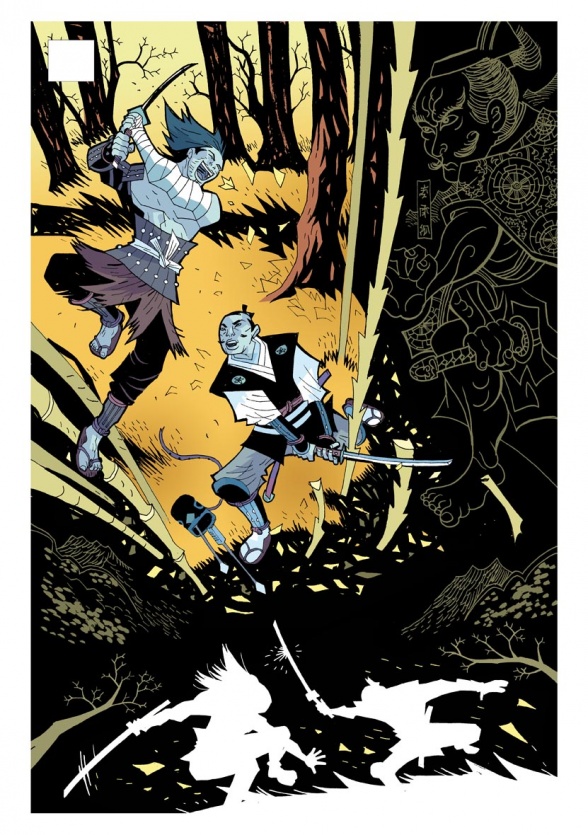It is great when two things you love can be combined into one perfect mix of their own greatness. Take an Oreo. A chocolate cookie is always good. Sweet, sugar, sometimes greasy frosting well that is also good. On their own they are both respectively good products but combine those into a chocolate cookie sandwich with a frosting center well now you have something I will consume till I feel shameful and sick. Victor Santos is doing just that with his new Dark Horse graphic novel “Rashomon: A Commissioner Heigo Kobayashi Case.” Just to be clear, I am not talking about the shameful sick part but the combining two awesome things, noir and samurais.
Santos has already shown off his talents in the noir genre with his spy trilogy of books by Dark Horse titled “Polar: Came from the Cold,” “Polar: Eye for an Eye,” and “Polar: No Mercy for Sister Maria.” Now, he is set to re-release his series “Rashomon: A Commissioner Heigo Kobayashi Case,” original published in Spain, through Dark Horse Comics for English readers. “Rashomon” merges Victor’s noir style art and aesthetic to the setting of a feudal Japanese samurai themed mystery. “When the body of a skilled samurai is found along the road to Yamashina in feudal Japan, the search begins for his killer. Detective Heigo Kobayashi takes the case but finds only dead-end clues and no firsthand witnesses.”
We spoke with Santos about the book’s origins, its re-release, and more. Be sure to look for “Rashomon: A Commissioner Heigo Kobayashi Case” in stores and digitally this October.

Rashomon is a classic film and a favorite of many people. “Rashomon: A Commissioner Heigo Kobayashi Case” is your newest graphic novel from Dark Horse Comics. What is your Rashomon story about and for those familiar with the film is any connection in your story?
Victor Santos: The origin of Rashomon came from my love for Akira Kurosawa and Japanese movies. When I was studying Fine Arts in college, honestly I didn’t enjoy a lot of the subjects, and most teachers considered comics a minor art. But I had a really cool teacher that imparted modern cinema and loved Asian cinema, from Michoguzi to John Woo. And there was “divx movies traffic” between students of that class, classic or author movies subtitled in English copied or lend. The internet was just beginning and the most powerful download tool we had then was Napster, so the way to get real foreign movies was if a friend copied a 700 meg cd. I watch a lot of cinema from every corner of the world and Kurosawa was one of my favorites.
Sp some year ago, when I was thinking on new projects years ago, I thought on an adaptation of some classic book free of rights. I visit a Kurosawa´s drawings exhibition in Spain and suddenly Rashomon appeared in my mind. Also, it was a crime story! Initially, the project was a literal adaptation of the original Akutagawa´s book but the character of Heigo Kobayashi (who doesn’t appear in the original tale) gained strength.
You have worked collaboratively on successful books like “Violent Love,” “Black Market,” “Filthy Rich,” and more but as a reader it always seemed you really push yourself creatively with your solo works. The visual storytelling in your “Polar” work is always amazing. How do you approach your solo titles? Do you find yourself experimenting more or using those titles as the works to push your style?
VS: I enjoy my collaborations because I learn a lot, but at the same time I keep always in mind I’m a part of a team. I always try to approach to the story in a creative way but never overlapping the story. My task is making the script more powerful, empowering its intentions and themes. My art needs to work for it, not using the story as a vehicle of my ostentation.
But my “Polar” trilogy, where I´m complete author, born as a storytelling experiment, so the story is build over the visual, almost as a old “Marvel style” comic-book. In “Rashomon,” the story is more dense but like I´m the writer, I can do a more experimental approach because I can shape the story at the same time. I build dialogue and structure at the same time than I´m drawing the pages. This is something difficult to do with other people involved because I can’t torture a writer making him write again and again the story meanwhile I´m drawing it.
Continued below
That doesn’t mean I consider my works with writers minor works, and in books like “Violent Love,” where the communication is so fluent with the writer, the final result is very similar to my [solo] books.
You have a very distinct art style that fits perfectly in the noir genre. How have you approached the look and feel of this book and story this time around?
VS: I always say I try to become the artist the book needs. I can’t imagine myself working with the same style book after book, it´s so boring. I tried to link the story with their two heritages: the noir and the Japanese classic culture. Ryonosuke Akutagawa´s Rashomon is surely the first modern noir story, its structure of different points of view it´s completely modern. It´s the kind of advanced skill you can find in Orson Wells’ Citizen Kane, in the Will Eisner´s “Spirit” or in the Osamu Tezuka´s work. You can´t find anything like these at their times.
I tried to honor that legacy doing something mixing the Japanese ink drawing art where the clear line is so important with the lights and shadows of the noir. I´m naming those traditions full of true masters and their level is lightyears of me, but I always kept those artistic references in mind.
I imagine Rashomon and other films of that style were influences on this title but what else are you bringing into this work from other influences?
VS: I love Japanese and Samurai films, from people like Masaki Kobayashi (the main character´s name was because of this director, and Heigo was the Kurosawa´s dearest brother) to the Lady Snowblood or Lone Wolf and Cub movies, manga books by auhtors like Kazuo Koike and Goseki Kojima, Hiroshi Hirata or Shotaro Ishinomori. Tons of crime books of James Ellroy and Jim Thompson, or comic-books by Matt Wagner, Mike Mignola, and Frank Miller.
Definitely Kurosawa has influenced me and overall how he shoots. I would need to write a book only about my influences and how I learn every day from awesome people, but I’ll tell you something I love. I find something similar between Kurosawa and Eisner: how they use the weather in their books. Frank Miller learned this from Eisner, you know, the rain in “Sin City” and things like these. Kurosawa is the master on this: rain, snow, wind… using it as an emotional element. I took a lot of things from this. I must say I never tried to do a remake of the movie because this is an impossible task but I tried to adapt to graphic novel some of his style features.
“Polar” is a case study on how to do noir well in comics. You use characteristics and the styles of the genre to tell a cohesive and always extremely sharp story. I mean so much so the online version had no dialog right? How do you then merge the genre of noir with that of samurais?
VS: I read noir because a friend of mine told me one of my favorite movies, Yojimbo, was a free adaptation of Dashiell Hammet´s Red Harvest. So I read the novel and felt in love. Since then, I´m a crime novels addict. And I loved both genres because they have a lot of common values: Characters with a strong moral code and people who break that code, stories placed during tumultuous times (Japanese civil wars, American Dry Law), a kind of almost fetishist devotion for the weapons.
Maybe in the Japanese stories there is a lack of strong female characters like the Femme fatale archetype, but Rashomon has only one interesting female character. Both worlds are really close.

Part one of “Rashomon” you had released previously in Spain, and “Polar” was a webcomic long before the Dark Horse hardcovers. What has it been like coming from the Spanish comics market and even adapting previous work for an English speaking audience?
VS: The second part of “Rashomon” was finally published in Spain, so there are two volumes, “Rashomon” & “Seppuku,” but we joined them together for the USA edition because Dark Horse preferred a 160 pages volume. It was easy to adapt because I could supervise the translation. We adjust some Spanish expressions and play on words.
Continued belowIn “Polar,” I wrote the dialogues in English with the help of a good friend of mine, a translator, and later with the editor we adjusted and fixed them to a more fluent style.
The “Polar” dialogue was written for the USA readers. But here, the most difficult part was its structure. Every “Polar” book is really a new cut, because you read different in a screen or in a book. For example, you need to put the surprises in a even page, or you will spoil them. You have not that problem advancing screen to screen.
But it´s so cool to create my own stuff and be the owner of my work. When I was beginning to self-publish my first comic-books in Spain, I was 19-20 years old (now I´m 39), my references where that “Legend” generation: Miller with “Sin City,” Mignola with “Hellboy,” Byrne with “Nextmen,” Adams with “Monkeyman,” and other great series like “Mage” or “Madman.” I wanted to do something like that in Spain, they were my model. But I never dreamed that I could get something like that in the US. Of course, I would love drawing a Batman or a Wolverine book sometime, I grew up with characters like them, but I find exciting, you know, adding new mythologies to the Pantheon.
Has the work changed since you released the first part in Spain with this upcoming release? I know a big one in the past was adding the speech bubbles/dialogue to “Polar.”
VS: The most significant change in “Rashomon” was colors, the original edition was black and white. I decided to color the USA edition. First, for commercial reasons because there is a big part of US readers who the black and white is still a problem for them. Second, because I wanted to differentiate “Rashomon” from “Polar,” they are different approaches to noir, and some extreme black and white parts of “Rashomon” remind a lot of the “Polar” book style. I need every book has its own identity. So I colored it myself, but using a different style than other books colored by me like “Violent Love” or “Furious,” and with the Japanese art I mentioned in mind.
For you as a fan of comics what makes a good noir comic?
VS: Well, this is my opinion but all of us, noir fans, love the noir aesthetics, you know: the deadly dames, guns, and cool shadows of Venetian blinds. And surely, this is the funny part in visual experiments like “Polar,” where I tried to push the archetypes of the genre to a super-stylized level.
But the core of the genre is about morals and who we live with them and how mark our life, and if we choose to broke them, what´s the reason. I think the genre can be an amazing exploring of the gleaming and darkest corners of the human souls.

What do you hope readers get out of this book? Where and When can readers get the “Rashomon: A Commissioner Heigo Kobayashi Case”?
VS: Above all I want to make entertainment and I want the reader have a good time with a good story and good characters. It´s not exclusively a story for noir addicts or experts in Japanese culture. It´s a mystery tale placed in the “pop culture” Japan, the Japan we know from our favorite movies or comic-books but with a western vision. So it´s the story of a man trying to resolve a crime, with difficulties, betrayals, and political interference, but with seduction, and katana fights and even ninjas working as the FBI.
The graphic novel will published on October 18th, you can reserve to your retailer. Dark Horse has good distribution in bookshops too, like Barnes & Noble. And of course, you can pre-order on Amazon. And you can get information about my work on my website and on Twitter, @polarcomic



